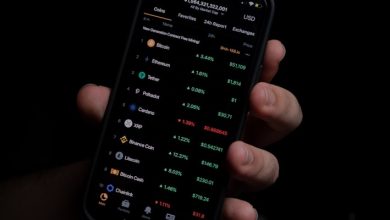Understanding Token Metrics: What Your Token Tracker Can Tell You

- The Importance of Token Metrics in the Crypto Space
- How Token Trackers Can Help You Make Informed Decisions
- Key Metrics to Look for When Analyzing Tokens
- Using Token Metrics to Evaluate Investment Opportunities
- Common Mistakes to Avoid When Interpreting Token Data
- Tips for Utilizing Token Trackers Effectively
The Importance of Token Metrics in the Crypto Space
Token metrics play a crucial role in the world of cryptocurrency. These metrics provide valuable insights into the performance and potential of a token, helping investors make informed decisions. By analyzing token metrics, investors can assess the viability of a project, understand its market position, and evaluate its growth prospects.
Some of the key token metrics to consider include market capitalization, circulating supply, total supply, trading volume, and price performance. Market capitalization gives an indication of a token’s overall value and popularity in the market. Circulating supply refers to the number of tokens currently in circulation, which can impact price dynamics. Total supply, on the other hand, indicates the maximum number of tokens that will ever be created, influencing scarcity and demand.
Trading volume is another important metric that reflects the level of activity and liquidity in the market. High trading volume suggests a vibrant market with active participation, while low volume may indicate limited interest or liquidity issues. Price performance, including historical price data and trends, can provide insights into the token’s price stability, volatility, and potential for growth.
Overall, token metrics offer a comprehensive view of a token’s fundamentals and performance, helping investors assess risks and opportunities. By tracking and analyzing these metrics, investors can make more informed decisions and better navigate the dynamic and volatile crypto space.
How Token Trackers Can Help You Make Informed Decisions
Token trackers can be invaluable tools for investors looking to make well-informed decisions in the cryptocurrency market. By utilizing a token tracker, you can gain access to a wealth of data and analytics that can help you better understand the performance and potential of various tokens.
One of the key ways in which token trackers can assist you is by providing real-time information on token prices, trading volume, market capitalization, and more. This data can give you a comprehensive overview of how a token is performing in the market at any given time, allowing you to make timely and informed decisions about buying, selling, or holding.
Furthermore, token trackers can also offer insights into the historical performance of a token, allowing you to track its price movements over time and identify any trends or patterns that may help you predict future price movements. This historical data can be crucial in helping you make smart investment decisions based on more than just current market conditions.
Key Metrics to Look for When Analyzing Tokens
When analyzing tokens, there are several key metrics that you should look for to gain a better understanding of the token’s performance and potential. These metrics can provide valuable insights into the token’s liquidity, market capitalization, trading volume, and more.
One important metric to consider is the token’s market capitalization, which can give you an idea of the token’s overall value and how it compares to other tokens in the market. Another crucial metric is trading volume, which can indicate how actively the token is being bought and sold.
Additionally, you should pay attention to metrics such as circulating supply, total supply, and maximum supply. These metrics can help you understand how many tokens are currently in circulation, how many tokens will be issued in the future, and what the maximum number of tokens that will ever exist is.
Other important metrics to consider include price performance, volatility, and token distribution. Price performance can give you an idea of how the token’s value has changed over time, while volatility can indicate how stable or risky the token is as an investment.
Overall, by analyzing these key metrics, you can gain a better understanding of a token’s potential and make more informed decisions about whether to buy, sell, or hold onto a particular token in your portfolio.
Using Token Metrics to Evaluate Investment Opportunities
Investors can leverage token metrics as a powerful tool to assess the potential of various investment opportunities within the cryptocurrency space. By utilizing a token tracker, investors can gain valuable insights into key metrics such as market capitalization, trading volume, price performance, and circulating supply. These metrics can help investors make informed decisions about which tokens to invest in based on their risk tolerance and investment goals.
One of the key metrics that investors should pay close attention to is market capitalization. Market capitalization provides investors with a snapshot of a token’s overall value in the market, calculated by multiplying the current price of the token by its total circulating supply. Tokens with high market capitalization are generally considered to be more stable and less volatile compared to tokens with lower market capitalization.
In addition to market capitalization, investors should also consider trading volume when evaluating investment opportunities. Trading volume reflects the level of activity surrounding a particular token, with higher trading volumes indicating greater liquidity and market interest. Tokens with high trading volumes are typically more liquid, making it easier for investors to buy and sell their positions without significantly impacting the token’s price.
Price performance is another crucial metric that investors should analyze when evaluating investment opportunities. Price performance tracks how a token’s price has fluctuated over time, allowing investors to assess the token’s historical performance and potential for future growth. By examining price performance charts and trends, investors can identify patterns and make more informed decisions about when to buy or sell a particular token.
Finally, investors should take into account the circulating supply of a token when assessing its investment potential. Circulating supply refers to the total number of tokens that are currently available in the market and can be freely traded. Tokens with limited circulating supply may have a higher value due to scarcity, while tokens with high circulating supply may face challenges in maintaining price stability.
Overall, by using token metrics to evaluate investment opportunities, investors can enhance their decision-making process and increase their chances of achieving successful outcomes in the cryptocurrency market.
Common Mistakes to Avoid When Interpreting Token Data
When interpreting token data, there are several common mistakes that should be avoided to ensure accurate analysis and decision-making. One common mistake is relying solely on one metric to make conclusions about a token’s performance. It is important to consider multiple metrics in conjunction to gain a comprehensive understanding of the token’s health and potential growth.
Another mistake to avoid is failing to take into account the context in which the token operates. Factors such as market trends, regulatory developments, and competitor activity can all impact a token’s performance and should be considered when interpreting token data.
Additionally, it is crucial to be aware of the limitations of token metrics. Not all metrics are created equal, and some may be more reliable indicators of a token’s value and potential than others. Understanding the strengths and weaknesses of each metric can help avoid misinterpretation of token data.
Lastly, it is important to not overlook the importance of qualitative analysis in addition to quantitative data. While token metrics can provide valuable insights, they should be used in conjunction with other forms of analysis to paint a complete picture of a token’s performance and potential.
Tips for Utilizing Token Trackers Effectively
When utilizing token trackers, there are several tips that can help you effectively analyze the data provided. Here are some key points to keep in mind:
- Pay attention to the token price trends over time to identify patterns and potential investment opportunities.
- Monitor the trading volume to gauge the level of interest and liquidity in the token.
- Look at the market capitalization to understand the overall value of the token in the market.
- Check the circulating supply to determine how many tokens are currently in circulation.
- Compare the token’s performance against other similar tokens to assess its competitiveness.
By following these tips and utilizing token trackers effectively, you can make informed decisions when it comes to investing in cryptocurrencies. Take advantage of the data available to you and stay informed about the latest trends in the market.



